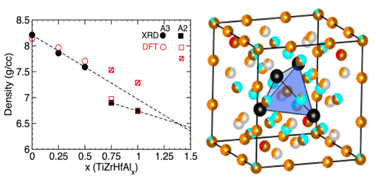
(Right) Vacancy ordering forms tetrahedron (black spheres) around the body center of a large BCC-type supercell.
How high-entropy alloys (a.k.a. multiple principal element alloys) accommodate entropy due to the mismatch in size and electronic charge remains an open question. Phase selection in Ti-Zr-Hf-Alx high-entropy alloys (x from 0 to 1) was investigated by density-functional-theory based electronic-structure methods that correctly address disorder and vacancies (missing atom defects found at processing temperatures). Cast samples of the same composition were analyzed using in-situ high-energy x-ray diffraction and single-crystal x-ray diffraction. Theory predicted formation enthalpy and chemical short-range order (SRO) with increasing aluminum content would change stability from HCP to a BCC phase. Furthermore, vacancies, which occur due to high processing temperatures, would alter the BCC stability to form a defect-modulated beta-brass-type superstructure with a four-vacancy-ordered tetrahedron. Such altered phase selection due to vacancies was experimentally confirmed. As vacancies are ubiquitous in refractory alloys, understanding how they suppress atomic SRO to favor vacancy ordering must be incorporated into their design, as done here by considering vacancies as an additional chemical species (or ”atom”).
Prashant Singh, S. Gupta, S. Thimmaiah, B. Thoeny, P. Ray, Andrei V. Smirnov, Duane D. Johnson*, and Matt Kramer, Vacancy-mediated complex phase selection in high-entropy alloys, Acta Materialia 194, 540-546 (2020). DOI: 10.1016/j.actamat.2020.04.063
